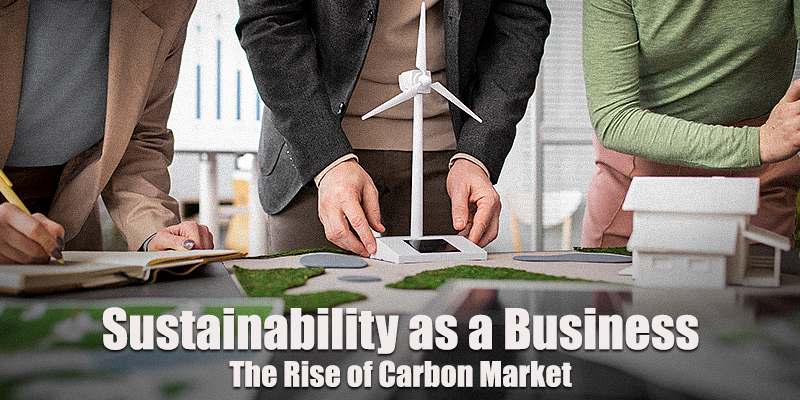Editor’s Note
Dr. Mahuya Basu teaches Finance at Globsyn Business School – one of the best business management colleges in Kolkata. With over 22 years of experience in teaching and academic administration, Dr. Basu’s last stint, in the capacity of a faculty and Head of the Department was at Footwear Design & Development Institute (FDDI), Kolkata. She was earlier associated as a faculty member in ICFAI National College and led several learning sessions for students in the field of Financial management, Economics and Business Research Methods, etc. Dr. Basu has several conference papers and journal publications to her credit, and has co-authored two books. One of her research papers has been awarded as the Third Best Paper from industry and academia in the International Conference of Nirma University; NICOM.
We usually hear the word ‘Sustainability’ and think of going green, saving the planet, or using less plastic. But there’s another side to it that’s growing fast – sustainability as a business. This isn’t just about companies being ‘eco-friendly’ for the headlines but many firms today are actually making money by helping reduce pollution and fight climate change.
In the simplest sense, business sustainability means running a company in a way that benefits people, the planet, and profits – the three bottom line, all at the same time. This can mean using clean energy, reducing waste, or even creating products and services that help others reduce their carbon footprint. It’s exactly the opportunity some companies are taking to convert ‘sustainability’ a marketable product. Imagine a factory like NTPC that emits carbon dioxide, a greenhouse gas that causes climate change and global warming. Now, imagine a group of farmers who, through adopting techniques, capture more carbon in the soil or capture methane or use fewer chemical fertilizers. Such emission reduction can actually be measured, verified, and turned into something called a carbon credit. One carbon credit equals one ton of CO₂ emissions reduced or avoided. Companies that pollute can now buy these credits to offset their emissions. This whole system is called the ‘Carbon Market’, and its growing fast.
Creating carbon credits isn’t just about plating some trees. There’s a proper process which includes identifying a project that helps reduce or avoid carbon emissions (like reforestation or sustainable farming), measure the impact, i.e., how much CO₂ is being reduced or captured, verify the data through third-party standards like Verra or Gold Standard, issue of the credits and finally take part in trading in a voluntary or compulsory carbon market and sell it to companies looking to offset their emissions. A good example is the firm ‘Grow Indigo’ – an Indian company that’s turning sustainable farming into a revenue-generating model. They work directly with farmers to implement regenerative agriculture techniques like crop rotation, cover cropping and minimal chemical use. These practices improve soil health and increase the soil’s ability to store carbon. Grow Indigo then measures the carbon captured through these methods and converts it into verified carbon credits. These credits are sold to companies that need offsets, and a portion of the revenue goes back to the farmers. In a win-win model it contributes to better soil quality, more income, and fewer emissions. This model proves that fighting climate change can actually can create value, especially for rural communities.
In tune with its ‘Net Zero’ goal by 2070 and with countries around the world move towards more organized carbon trading systems, the government of India has announced that by 2026, it will initiate its own structured carbon credit market. This plan, led by the Bureau of Energy Efficiency (BEE) and the Ministry of Power, would include carbon trading as a formal part of our climate strategy. It’ll start by covering sectors like power, steel, cement, and transport and gradually bring in more industries over time. This adds transparency, credibility, and easy verification of carbon credit. That’s where companies like Grow Indigo are perfectly positioned. Their whole model of helping farmers to adopt sustainable agriculture and turn those efforts into carbon credits fits right into this future. Once the carbon market is live and active, these businesses could scale up fast, attract bigger buyers, and bring in serious revenue. This can create a whole green economy – where climate action isn’t just a cost, but an opportunity for everyone, from corporates to small farmers.
Sustainability isn’t just a buzzword anymore, and it’s definitely not just a side project for companies. It’s becoming a full-fledged business opportunity. That’s the reason why it’s become so important for students, entrepreneurs, and future business leaders to start learning about ESG (Environmental, Social, and Governance) and sustainability practices. These aren’t just “good to know” topics anymore, they’re becoming core to how businesses operate and compete. In the near future, knowing how to manage ESG risks, build sustainable strategies, and create climate-positive value could be as important as knowing finance or marketing. Whether you’re launching a startup, working in corporate, or advising policy, sustainability will be at the heart of smart decision-making.
Globsyn Business School is one of the very few who has already foresighted this requirement and has included ESG and Corporate Sustainability as a credit course in its structure thereby remain committed to create responsible leaders and incorporating innovations.

Prof. (Dr.) Mahuya Basu
Faculty – Finance
Globsyn Business School


